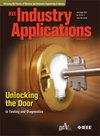扩展状态观测器滑模控制增强smb - dvr的电压响应
IF 4.5
2区 工程技术
Q2 ENGINEERING, ELECTRICAL & ELECTRONIC
引用次数: 0
摘要
基于超导磁体储能的DVR (SMES-DVR)可以在毫秒内提供更高的功率来补偿电压干扰。然而,smb - dvr的非线性和负载扰动通常会引起直流链路上的电压波动,从而降低了精度和响应性能。针对smb - dvr直流链路电压波动的关键问题,提出了一种基于扩展状态观测器的高阶滑模控制(ESO-HOSMC)的复合控制策略。ESO-HOSMC控制方法通过将基于扩展状态观测器的扰动估计与超扭转高阶滑模控制相结合,有效地平衡了超导磁体充放电过程中快速响应与运行稳定性之间的矛盾,同时降低了敏感负载电压的总谐波畸变。理论分析包括控制器建模、设计和稳定性分析。此外,还比较了SMES-DVR的ESO-HOSMC控制、模型预测控制(MPC)和常规PI控制在不同电压跌落和膨胀情况下的性能。结果表明,所提出的控制方案有效地提高了smb - dvr的补偿性能和直流母线电压的稳定性。本文章由计算机程序翻译,如有差异,请以英文原文为准。
Enhanced Voltage Response of SMES-DVR via Sliding Mode Control With Extended State Observer
A DVR based on superconducting magnet energy storage (SMES-DVR) could offer higher power in milliseconds to compensate for the voltage disturbance. However, nonlinearities and load disturbances of SMES-DVR usually induce voltage fluctuations on DC-link, which reduces the accuracy and response performance. A novel composite control strategy based on high-order sliding mode control with extended state observer (ESO-HOSMC) is proposed to address the critical challenge of DC-link voltage fluctuations in SMES-DVR. By synergizing extended state observer-based disturbance estimation with super-twisting high-order sliding mode control, ESO-HOSMC control method effectively balances the contradiction between rapid response and operational stability during the charging and discharging process of the superconducting magnet, while reducing total harmonic distortion of sensitive load voltage. Theoretical analysis containing controller modeling, designing and stability analysis has been demonstrated. In addition, performances among the ESO-HOSMC control, model predictive control (MPC) and conventional PI control of SMES-DVR have been compared under different voltage sag or swell scenarios. The results show that the proposed control scheme effectively elevates compensation performance and the stability of DC bus voltage for SMES-DVR.
求助全文
通过发布文献求助,成功后即可免费获取论文全文。
去求助
来源期刊

IEEE Transactions on Industry Applications
工程技术-工程:电子与电气
CiteScore
9.90
自引率
9.10%
发文量
747
审稿时长
3.3 months
期刊介绍:
The scope of the IEEE Transactions on Industry Applications includes all scope items of the IEEE Industry Applications Society, that is, the advancement of the theory and practice of electrical and electronic engineering in the development, design, manufacture, and application of electrical systems, apparatus, devices, and controls to the processes and equipment of industry and commerce; the promotion of safe, reliable, and economic installations; industry leadership in energy conservation and environmental, health, and safety issues; the creation of voluntary engineering standards and recommended practices; and the professional development of its membership.
 求助内容:
求助内容: 应助结果提醒方式:
应助结果提醒方式:


